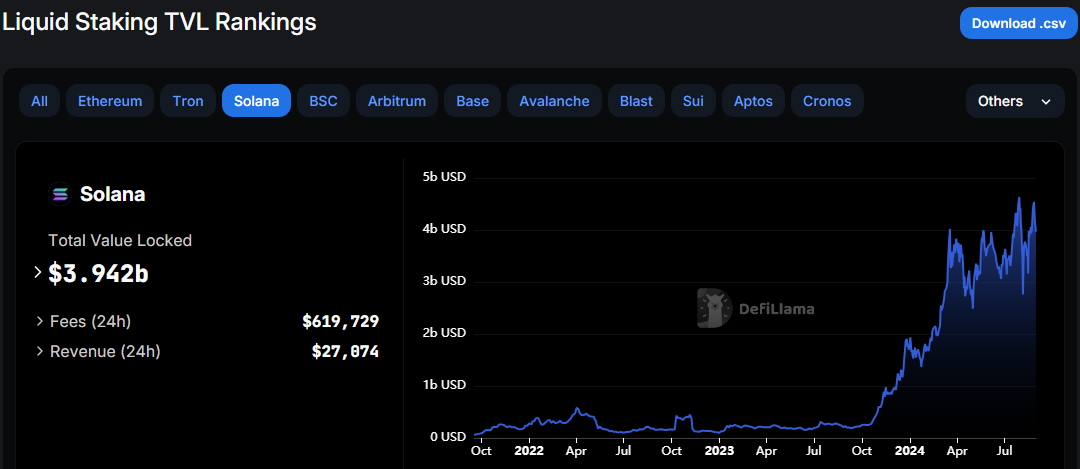币安、Bybit Eye增长Solana液体赌注市场
币安、Bybit和Bitget计划在Solana上推出流动性质押代币,以增强区块链的质押生态系统和流动性。
- 币安和其他交易所计划在Solana上进行LST,这标志着液体赌注生态系统的不断发展。
- BNSAL等LST将提供收益率和DeFi访问,从而增加交易所的收入和Solana的流动性。
- 在主要交易所和投资者兴趣增加的推动下,索拉纳的流动性股权TGL在2024年飙升至39亿美元。

币安是全球交易量最大的加密货币交易所,计划与其他交易所一起在Solana区块链上推出流动性赌注代币(LST)。
此举出台之际,索拉纳的液体赌注生态系统不断发展,吸引了主要行业参与者的兴趣。
将进军SAL液体赌注
周四,币安、Bybit和Bitget暗示计划通过神秘消息在Solana区块链上推出新的流动赌注代币(LST)。Bybit的液体赌注代币将携带股票代码BBSAL,而Bitget的将是BGSAL。币安将使用BNSAL作为其LST的符号。
这些代币将使持有者能够在参与贷款和借款等去中心化金融(DeFi)活动的同时从所持Solana(SAL)债券中赚取收益。此外,他们将通过赌注帮助保护区块链。Sanctum是Solana上的液体桩层,它建议这些LST将基于其协议构建。
“BBSAL将成为Bybit集中式交换机(CEX)和Web 3平台之间的桥梁,为用户提供一致且可靠的奖励。通过在Bybit Web 3上下注Solana(SAL),用户可以获得BBSAL代币,从而释放Bybit的CEX和Web 3产品中的丰富盈利机会,”Bybit与BeInCrypto分享道
阅读更多:什么是加密货币中的液体赌注?
在这一消息的影响下,Sanctum的ClouUD代币飙升了47%,截至撰写本文时交易价格为0.2629美元。Greythorn Asset Management高级合伙人Jae Sik Choi将这一进展描述为对Sanctum的乐观,并预测价值高达30亿美元的Solana可能会增加到赌注层的总锁定价值(TFL)中。
“BNSAL-币安的LST可能会在Sanctum赌注层TTL中增加价值30亿美元的SAL。一旦本地股权转换为LST,TFL可能会增加55.48%,”他写道。
Sik Choi表示,币安、Bitget和Bybit可能已经启动了集中式交易所(CEX)LST季节,这可能会提高Sanctum的价值。除了Sanctum之外,Solana上的其他赌注层,例如Jito、Marinade、Jupiter和Blaze,也为Solana流动赌注市场的增长做出了贡献。
2024年Solana液体博彩市场翻一番
根据DefiLlama的数据,2024年,Solana的液体质押总价值锁定(TTL)增加了一倍多,从19亿美元增加到39.4亿美元。自2021年成立以来,该行业取得了令人印象深刻的增长,吸引了大量参与者。
然而,39亿美元的TFL仅占所有流动性质押协议锁定的425亿美元中的9.6%。以太坊仍然在该领域占据主导地位,占据总市场份额的83%。

流动性赌注协议越来越受欢迎,因为它们将对网络共识的安全贡献与财务灵活性相结合,使其成为旨在实现利润最大化的精明投资者的有吸引力的选择。
对于交易所来说,引入LST增加了新的收入来源,因为这些代币扩大了其产品范围。利益相关者获得奖励,而交易所收取费用。例如,提供BETH(按市值计算第三大LST)的币安对以太坊(ETH)赌注奖励收取10%的费用。
阅读更多:2024年值得关注的8个高收益率液体赌注平台
根据币安的支持页面,这10%的费用涵盖运营成本,包括验证器节点的硬件和网络维护。此外,BNSAL、BBSAL和BGSAL等LST将允许交易所在其平台上保留Solana余额。
免责声明:本文观点来自原作者,不代表Hawk Insight的观点和立场。文章内容仅供参考、交流、学习,不构成投资建议。如涉及版权问题,请联系我们删除。